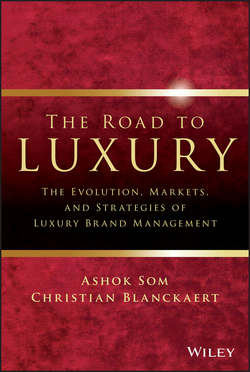Читать книгу The Road To Luxury - Blanckaert Christian - Страница 17
На сайте Литреса книга снята с продажи.
Chapter 2
Evolution of the Global Luxury Market
How Has It Changed?
ОглавлениеPlus ça change, plus c'est la même chose.
– Jean-Baptiste Alphonse Karr
Two decades ago, the luxury industry model was almost completely dominated by the family businesses. However, the winds of change were felt in the 1990s, especially by one man – Bernard Arnault. The ensuing rivalry between Bernard Arnault, the owner of Dior Group, and Henry Racamier, husband of Mademoiselle Vuitton, owner of Louis Vuitton, created a historic structural shift within the industry as each selfishly fought for market control through growth and acquisition. Until then, luxury was about fashion. Within this struggle, Bernard Arnault came out the winner and went ahead for consolidation to create the luxury empire of today. He transformed the fashion into a business. Buying and selling companies with intricate financial maneuvers, he conquered the luxury space by making Louis Vuitton Moët Hennessy (LVMH) the largest luxury conglomerate in the world. The interesting point to note about this conglomerate is that each brand was allowed to carry on its own culture and know-how and to be managed separately. However, if it was felt that the brand needed a push, Arnault stood right behind it. Furthermore, he created the famous notion of “star brands” that were timeless, modern, fast-growing, and highly profitable. He would find new brands and mix and match a suitable designer and an apt management team for the brand. He would revamp the production, control, storage, distribution, to offer a completely new and unique package to the customer. Thus, it led to the development of the counterintuitive idea of “constrained freedom,” wherein the brands were allowed latitude; however, the latitude was limited to the lines that Arnault drew.
Some French companies, such as Hermès, which was owned by the families of Dumas, Puech, and Guerrand, and Chanel, which was owned by the Weirthemer family, could stay partially and fully independent. Hermès, the legendary leather-goods fashion house established in 1837, remained family owned. The Wertheimer family has owned Chanel since 1954. They never introduced Chanel to the stock market. The house is showing longevity in its independence, which is rare in the sector. Not listed on the stock market, the Maison Chanel continues to meticulously keep their financial data a top secret. Its aura of mystery is cultivated by the owners, Alain and Gérard Wertheimer, who drive the company firmly and discreetly.
In France, the Comité Colbert, founded in 1954 by Jean-Jacques Guerlain, consists today of 75 houses of French luxury that have different histories, cultures, sizes, and management. However, they share common governance rules and are willing to promote their values and know-how. The term “houses,” as opposed to the luxury company members of the Comité Colbert, illustrates their respective stories, the transmission of their know-how from one generation to another, which keeps their creation secrets. Indeed, most of the members or familial business, and the family CEOs of the Comité Colbert, call each other “chef de Maison.”
In Italy, Altagamma (Italian Association of Industries of Alta Gamma), founded in 1992, is an association whose purpose is to promote the work of several Italian companies on an international level and encourage their development. Currently the Foundation Altagamma brings together 76 Italian companies operating in the fields of fashion, design, transport, jewelry, shoes, perfume, and hospitality.
Despite these tectonic shifts in this industry, the family business remained a paramount and dominating factor in the Italian luxury enterprise until the last decade. Slowly but steadily some famous brands were acquired by the three multibrand conglomerates – LVMH, Richemont, and Kering Group. LVMH, after acquiring more than 60 luxury brands, acquired two of the largest Italian groups, Bulgari and Loro Piana, in 2011 and 2013 respectively. Gucci, Brioni, Bottega Veneta, and others were acquired by Kering in Italy and in France. The more recent crisis has spurred a desperate fight for survival, pushing the luxury industry further away from its historic structure as the key factors of success become finance instead of family, and the focus shifts from the small artisan businesses to the colossal conglomerates.
